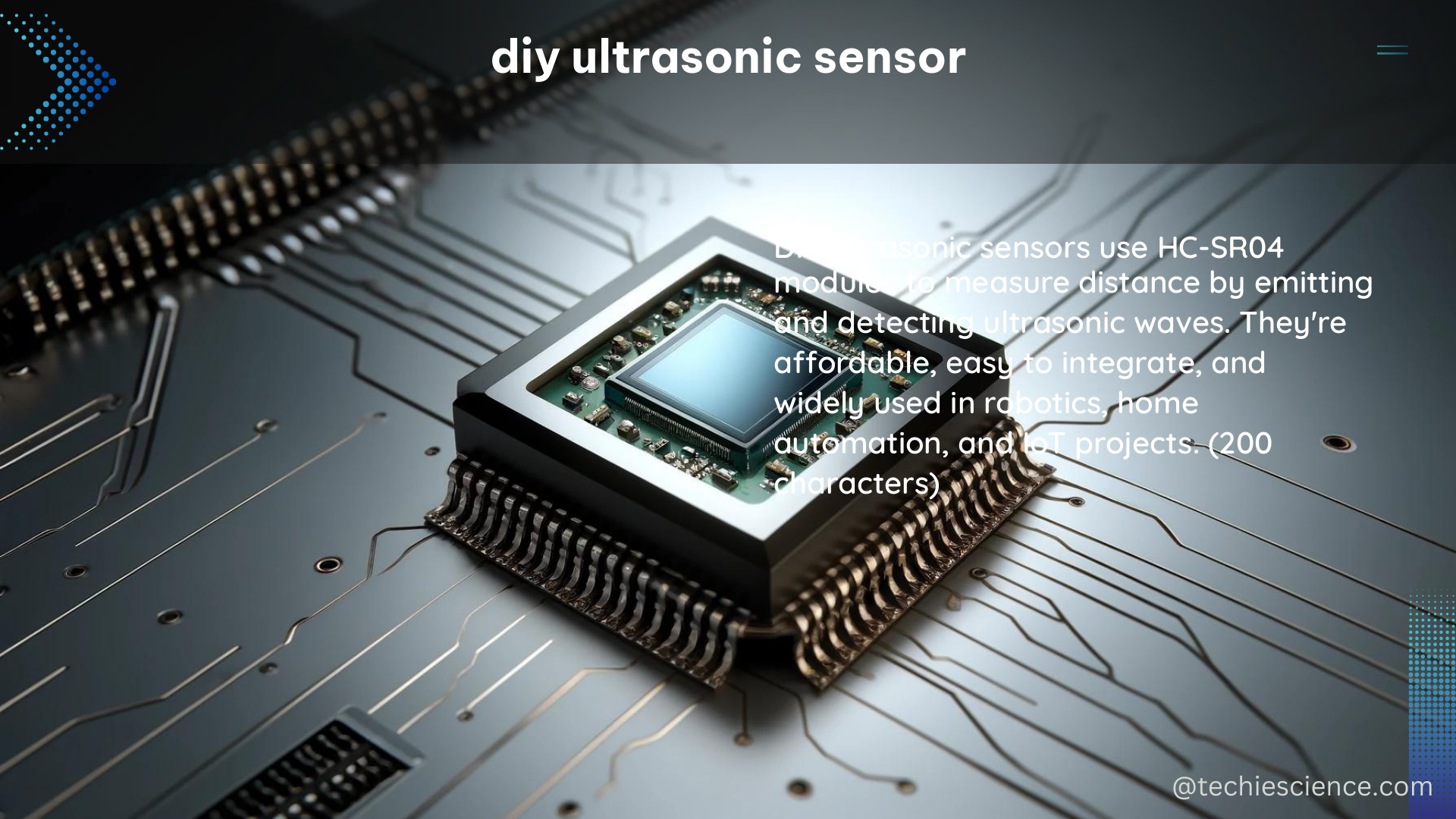The HC-SR04 ultrasonic sensor is a popular choice for distance measurement in various DIY projects, offering a measurement range of 2cm to 400cm with an accuracy of 3mm. This sensor works by emitting ultrasonic waves and measuring the time it takes for the waves to reflect off an object and return to the receiver, allowing for precise distance calculations.
Understanding the Working Principle
The working principle of the ultrasonic sensor is based on the time-to-distance conversion. When the sensor is triggered, it emits a high-frequency ultrasonic pulse, typically around 40 kHz. This pulse travels through the air at the speed of sound, which is approximately 344 m/s (1,125 ft/s) at room temperature. When the pulse encounters an object, it is reflected back to the sensor’s receiver.
The time taken by the pulse to reach the object and return to the receiver is measured, and the distance is calculated using the formula:
Distance = (Speed of Sound × Time Taken) / 2
Since the speed of sound is a known constant, the distance can be determined by measuring the time it takes for the pulse to travel to the object and back.
Hardware Setup

To build a DIY ultrasonic sensor using the HC-SR04, you will need the following components:
- HC-SR04 Ultrasonic Sensor: This sensor consists of an ultrasonic transmitter, a receiver, and a control circuit.
- Arduino Board: The Arduino board is used to control the sensor and perform the necessary calculations.
- Jumper Wires: These are used to connect the sensor to the Arduino board.
The connections between the HC-SR04 sensor and the Arduino board are as follows:
| HC-SR04 Pin | Arduino Pin |
|---|---|
| VCC | 5V |
| Trig | Digital Pin 3 |
| Echo | Digital Pin 2 |
| GND | GND |
Software Setup
To program the Arduino board to work with the HC-SR04 ultrasonic sensor, you can use the Arduino IDE. Here’s an example code that demonstrates how to measure the distance using the sensor:
#define echoPin 2 // attach pin D2 Arduino to pin Echo of HC-SR04
#define trigPin 3 // attach pin D3 Arduino to pin Trig of HC-SR04
long duration; // Variable to store time taken to the pulse
int distance; // Variable to store distance calculated using formula
void setup() {
pinMode(trigPin, OUTPUT); // Sets the trigPin as an OUTPUT
pinMode(echoPin, INPUT); // Sets the echoPin as an INPUT
Serial.begin(9600); // Serial Communication is starting with 9600 of baudrate speed
Serial.println("Distance measurement using Arduino Uno.");
delay(500);
}
void loop() {
// Clear the trigPin
digitalWrite(trigPin, LOW);
delayMicroseconds(2);
// Set the trigPin on HIGH state for 10 microseconds
digitalWrite(trigPin, HIGH);
delayMicroseconds(10);
digitalWrite(trigPin, LOW);
// Read the echoPin, returns the sound wave travel time in microseconds
duration = pulseIn(echoPin, HIGH);
// Calculate the distance
distance = duration * 0.034 / 2; // Speed of sound wave divided by 2 (go and back)
// Print the distance on the Serial Monitor
Serial.print("Distance: ");
Serial.print(distance);
Serial.println(" cm");
delay(1000);
}
This code initializes the trigPin and echoPin, sets the baud rate for serial communication, and calculates the distance using the pulseIn() function to measure the time taken by the pulse. The distance value is then printed on the serial monitor every second.
Advanced Features and Customizations
The HC-SR04 ultrasonic sensor can be further customized and enhanced for more advanced applications. Here are some additional features and modifications you can explore:
- Multiple Sensor Integration: You can use multiple HC-SR04 sensors to create a more comprehensive distance measurement system, allowing for the detection of objects from different angles or in a wider area.
- Distance Mapping: By combining multiple sensors, you can create a 2D or 3D map of the surrounding environment, which can be useful for applications like robot navigation or object detection.
- Obstacle Avoidance: The distance data from the ultrasonic sensor can be used to detect obstacles and implement obstacle avoidance algorithms, making it suitable for robotics and autonomous vehicle applications.
- Gesture Recognition: The HC-SR04 sensor can be used in conjunction with other sensors, such as accelerometers or gyroscopes, to enable gesture recognition, which can be useful for human-computer interaction or control systems.
- Data Visualization: You can integrate the ultrasonic sensor data with a display or a computer to visualize the measured distances, which can be helpful for monitoring and analysis purposes.
- Wireless Communication: By adding a wireless module, such as a Bluetooth or Wi-Fi module, you can transmit the sensor data wirelessly, enabling remote monitoring and control.
- Environmental Compensation: The speed of sound in air can be affected by factors like temperature, humidity, and air pressure. You can implement algorithms to compensate for these environmental changes and improve the accuracy of the distance measurements.
Conclusion
The HC-SR04 ultrasonic sensor is a versatile and cost-effective solution for distance measurement in various DIY projects. By understanding its working principle, hardware setup, and software implementation, you can create a wide range of applications that leverage the sensor’s capabilities. From simple distance monitoring to advanced robotics and automation, the HC-SR04 ultrasonic sensor offers a powerful and flexible platform for your DIY endeavors.
References
- Plotting Live data using Ultrasonic sensor + Arduino + Python
- Arduino Tutorial 55: Measuring Distance With HC-SR04 Ultrasonic Sensor
- Ultrasonic Sensor and LCD on Arduino for Distance Measurements
- Distance measurement using Ultrasonic sensor and Arduino
- Arduino Code for Ultrasonic Sensor HC-SR04

The lambdageeks.com Core SME Team is a group of experienced subject matter experts from diverse scientific and technical fields including Physics, Chemistry, Technology,Electronics & Electrical Engineering, Automotive, Mechanical Engineering. Our team collaborates to create high-quality, well-researched articles on a wide range of science and technology topics for the lambdageeks.com website.
All Our Senior SME are having more than 7 Years of experience in the respective fields . They are either Working Industry Professionals or assocaited With different Universities. Refer Our Authors Page to get to know About our Core SMEs.